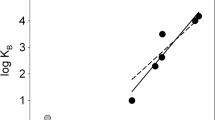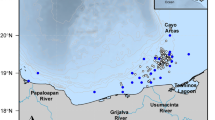Abstract
The acute toxicity of aliphatic and aromatic mono and diesters in two eucaryotic organisms was compared. The test systems were the static 2-d Tetrahymena pyriformis 50% population growth impairment (IGC −150 ) assay, and the flow-through 4-d Pimephales promelas 50% mortality (LC −150 ) assay. In ciliates, esters act via the nonpolar narcosis mechanism of toxic action. This was indicated by: the high quality 1-octanol/water partition coefficient (log Kow) dependent quantitative structure-activity relationship (QSAR), log IGC −150 =0.79 (log Kow)−1.93, n=15, r2=0.945, s=0.22, f=222.37 Pr>f=0.0001); volume fraction (Vf) (0.8e-02); and “a” coefficient (0.3) which are not different from other nonpolar narcotics. In vivo hydrolysis in Tetrahymena appears to be insignificant. However, in fish, presumably because of more active esterases, in vivo hydrolysis is significant and leads to greater toxicity of esters than observed for nonpolar narcotics. Moreover, it leads to a unique high quality QSAR, log LC −150 =0.64 (log Kow)−0.64, n=14, r2=0.945, s=0.22, f=207.08, Pr>f=0.0001). Due to in vivo hydrolysis, a nonreducing concentration gradient is formed between water and fish. Therefore, the fish take up more toxicant as compared to a situation that leads to thermodynamic equilibrium. Additional information about the mechanism of ester toxicity in fish was gained by applying corrections for hydrolysis in volume fraction analyses. The corrected Vf (0.6e-02) is very close to the one found for nonpolar narcotics (0.7e-02). These analyses suggest that esters which hydrolyze to an acid and aliphatic alcohol act as nonpolar narcotics. Moreover, the mechanism of toxic action of esters that yield a phenol upon hydrolysis is mixed and represents polar and nonpolar narcoses.
Similar content being viewed by others
References
Abernethy SG, Mackay D (1987) A discussion for correlations for narcosis in aquatic species. In: Kaiser KLE (ed) QSAR in Environmental Toxicology — II. D. Reidel Publishing Co., Dordrecht, p 1–16
Abernethy SG, Mackay D, McCarty LS (1988) “Volume fraction” correlation for narcosis in aquatic organisms: The key role of partitioning. Environ Toxicol Chem 7:469–481
Anderson E, Veith GD, Weininger D (1987) SMILES: A line notation and computerized interpreter for chemical structures. USEPA Environmental Research Brief, EPA/600/M-87 021
Broderius SJ, Kahl M (1985) Acute toxicity of organic chemical mixtures to the fathead minnow. Aquat Toxicol 6:307–322
Center for Lake Superior Environmental Studies, University of Wisconsin-Superior (1984) Brooke LT, Call DJ, Geiger DL, Northcott CE (eds) Acute Toxicities of Organic Chemicals to Fathead Minnows (Pimephales promelas) Vol. 1. Superior, Wisconsin, p 414
— (1985) Geiger DL, Northcott CE, Call DJ, Brooke LT (eds) Acute Toxicities of Organic Chemicals to Fathead Minnows (Pimephales promelas) Vol. 2. Superior, Wisconsin, p 326
— (1986) Geiger DL, Poirier SH, Brooke LT, Call DJ (eds) Acute Toxicities of Organic Chemicals to Fathead Minnows (Pimephales promelas) Vol. 3. Superior, Wisconsin, p 328
— (1988) Geiger DL, Call DJ, Brooke LT (eds) Acute Toxicities of Organic Chemicals to Fathead Minnows (Pimephales promelas) Vol. 4. Superior, Wisconsin, p 355
— (1990) Geiger DL, Brooke LT, Call DJ (eds) Acute Toxicities of Organic Chemicals to Fathead Minnows (Pimephales promelas) Vol. 5. Superior, WI, 332 pp
Drossman H, Johnson H, Mill T (1988) Structure activity relationships for environmental process 1: Hydrolysis of esters and carbonates. Chemosphere 17:1509–1530
Elliott AM (1973) Biology of Tetrahymena, Dowden, Hutchinson & Ross, Inc., Stroudsburg, PA, 508 pp
Jaworska JS, Schultz TW (1993) Quantitative relationships of structure-activity and volume fraction for selected nonpolar and polar narcotics chemicals. SAR QSAR Environ Res 1:3–19
Kamlet MJ, Doherty RM, Taft RW, Abraham MH, Veith GD, Abraham DJ (1987) Solubility Properties in Polymers and Biological Media. 8. An analysis of the factors that influence toxicities of organic nonelectrolytes to the golden orfe fish (Leucidiscus idus melanotus). Environ Sci Technol 21:149–155
Kamlet MJ, Doherty RM, Veith GD, Taft RW, Abraham MH (1986) Solubility Properties in Polymers and Biological Media. 8. An analysis of the factors that influence toxicities of organic nonelectrolytes to the golden orfe fish (Photobacterium phosphoreum). Environ Sci Technol 20:690–695
Kimitikado M, Tachino S (1961) Digestive enzymes of rainbow trout II esterases. Chem Abstr 55:5789c
Leo A, Weininger D (1988) MEDCHEM software release 3.53, Pomona Medical Chemistry Project, Pomona College, Claremont, CA
Lipnick R (1986) Charles Ernest Overton: Narcosis studies and a contribution to general pharmacology. Trends Pharmacol Sci 7:161–164
McKim JM, Bradbury SP, Niemi GJ (1987) Fish acute toxicity syndromes and their use in the QSAR approach to hazard assessment. Environ Health Perspect 71:171–186
Miller K, Paton WBM, Smith RA, Smith EB (1983) The pressure reversal of anesthesia and the clinical volume hypothesis. Mol Pharmacol 9:131–143
Morishita T, Noda H, Kitamikado M, Takahashi T, Tachino S (1966) The activity of the digestive enzymes in fish. Chem Abstr 64:7093b
Mullins LJ (1954) Some physical mechanisms in narcosis. Chem Rev 54:289–323
Parsons JR, Opperhuizen A, Hutzinger O (1987) Influence of membrane permeation on biodegradation kinetics of hydrophobic compounds. Chemosphere 16:1361–1370
SAS Institute Inc. (1989) SAS/STAT user's guide, version 6, fourth edition, Vol. 2. Cary, NC, 846 pp
Schultz TW, Cajina-Quezada M (1982) Structure toxicity relationships of selected nitrogenous hetercyclic compounds II. Dinitrogen molecules. Arch Environ Contam Toxicol 11:353–361
Schultz TW, Holcombe GW, Phipps GL (1986) Relationships of quantitative structure-activity to comparative toxicity of selected phenols in the Pimephales promelas and Tetrahymena pyriformis test systems. Ecotoxicol Environ Saf 12:146–153
Schultz TW, Lin DT, Wilke TS, Arnold LM (1990a) Quantitative structure-activity relationships for Tetrahymena pyriformis population growth endpoint: A mechanism of action approach. In: Karcher W, Devillers J (eds) Practical Applications of Quantitative Structure-Activity Relationships (QSAR) in Environmental Chemistry and Toxicology. Kluwer Academic Publishers, Dordrecht, pp 241–262
Schultz TW, Wyatt N, Lin DT (1990b) Structure-toxicity relationships for nonpolar narcosis: a comparison of data from the Tetrahymena, Photobacterium and Pimephales systems. Bull Environ Contam Toxicol 44:67–72
Schultz TW, Tichy M (1993) Structure-toxicity relationships for unsaturated alcohols to Tetrahymena pyriformis: C5 and C6 analogs and primary propargylic alcohols. Bull Environ Contam Toxicol 51:681–688
Schultz TW, Jaworska JS, Hunter R (1994) Volume fraction analyses for selected mechanisms of toxic action. In: Hughes JS, Biddinger GR, Mones E (eds) Environmental Toxicology and Risk Assessment: Third Volume, ASTM STP 1218. Amer Soc Test Mater, Philadelphia
Seeman P (1972) The membrane actions of anesthetics and tranquilizers. Pharmacol Rev 24:4583–655
Veith GD, Broderius SJ (1987) Structure-toxicity relationships for industrial chemicals causing type II narcosis syndrome. In: Kaiser KLE (ed) QSAR in Environmental Toxicology—II D. Reidel Publishing Co., Dordrecht, p 385–391
— (1990) Rules for distinguishing toxicants that cause type I and type II narcosis syndromes. Environ Health Perspect 87:207–211
Veith GD, DeFoe DL, Knuth ML (1984–1985) Structure-activity relationships for screening organic chemicals for potential ecotoxicity effects. Drug Metab Rev 15:1295–1303
Veith GD, Lipnick RL, Russom CL (1989) The toxicity of acetylenic alcohols to the fathead minnow, Pimephales promelas: Narcosis and proelectrophile activation. Xenobiotia 19:555–565
Wells PR (1968) Linear Free Energy Relationships, Academic Press, NY, 116 pp
Wolfe NL, Steew WC, Burns LA (1980) Phthalate ester hydrolysis: Linear free energy relationships. Chemosphere 9:403–408
Author information
Authors and Affiliations
Rights and permissions
About this article
Cite this article
Jaworska, J.S., Hunter, R.S. & Schultz, T.W. Quantitative structure-toxicity relationships and volume fraction analyses for selected esters. Arch. Environ. Contam. Toxicol. 29, 86–93 (1995). https://doi.org/10.1007/BF00213091
Received:
Revised:
Issue Date:
DOI: https://doi.org/10.1007/BF00213091




